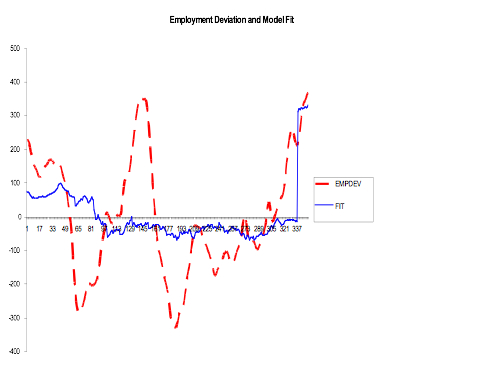Many years ago a visiting econometrician from the US gave a public lecture in which he mentioned that a secretary who was typing his material thought that “econometrics” should be typed as “economic tricks”. Last week the Prime Minister is reported to have said that economist Richard Blandy had estimated Labor’s plan to abolish WorkChoices would destroy between 200,000 and 400,000 jobs. This was apparently based on an econometric model that was reported on in the Australian Financial Review on August 29, 2007. It needs to be appreciated that the conclusion is indeed a type of “trick”.
Blandy claimed that WorkChoices has added something like 290,000 jobs. When teaching econometrics to students one always argues that they should plot the data to get some idea of what they are trying to explain. Later, after they have finished the modeling, it is a good idea to see what the model did explain.
Following this advice one would get the figure below.
Advertisement

The quite volatile dashed line is the variable Blandy was explaining - deviations from employment after trend - and the solid line called “fit” are the predictions of his model. WorkChoices was introduced in May 2006 where the jump in the solid line takes place.
Now the first observation is that there was a high growth in employment before WorkChoices. Moreover, the model looks singularly unimpressive as a model of employment over that period. Things seem to change after the advent of WorkChoices. Such marked differences inevitably makes one suspicious.
There is a simple explanation of the “improved fit”. It is a consequence of the way in which Blandy allows for WorkChoices in his regression - through a so-called “dummy variable”. This variable goes from zero before the introduction of WorkChoices to the value of one when WorkChoices comes in during March 2006. No matter what the effect of WorkChoices is one will find that the amount attributed to it by Blandy’s regression will be very close to the average of the employment change after its introduction. This is simply an artifact of the way in which the analysis is done and has no causal significance whatever.
Obviously there was some other factor (or factors) - X - that caused the big rise in employment before WorkChoices. If X is still operating after March 2006 then its effects will be attributed in Blandy’s regression to WorkChoices. Unless an attempt is made to control for X, there can be no confidence that WorkChoices has had any effect.
To emphasise the foolishness of all this I replaced the WorkChoices dummy with a Rudd dummy. It is constructed in the same way as the WorkChoices dummy - zero until Rudd took over as leader of the ALP in December 2006 and then unity. Interpreted in the same way as Blandy interprets the WorkChoices results it would imply that Rudd has added many jobs- in fact 10 per cent more jobs a month than WorkChoices did.
Advertisement
This type of work is akin to the famous quote from Wallace Irwin that “Statistics show that of those who contract the habit of eating, very few survive”.
First published at John Quiggin’s blog on November 16, 2007.
Discuss in our Forums
See what other readers are saying about this article!
Click here to read & post comments.
1 post so far.